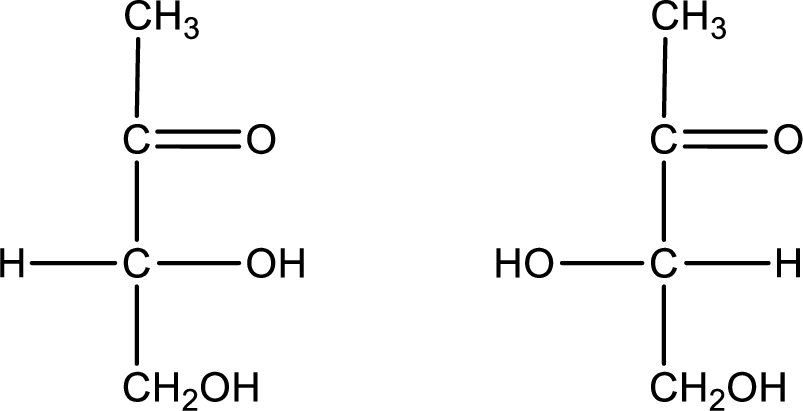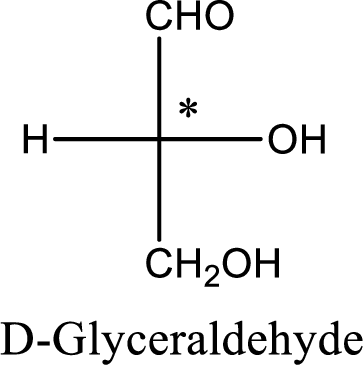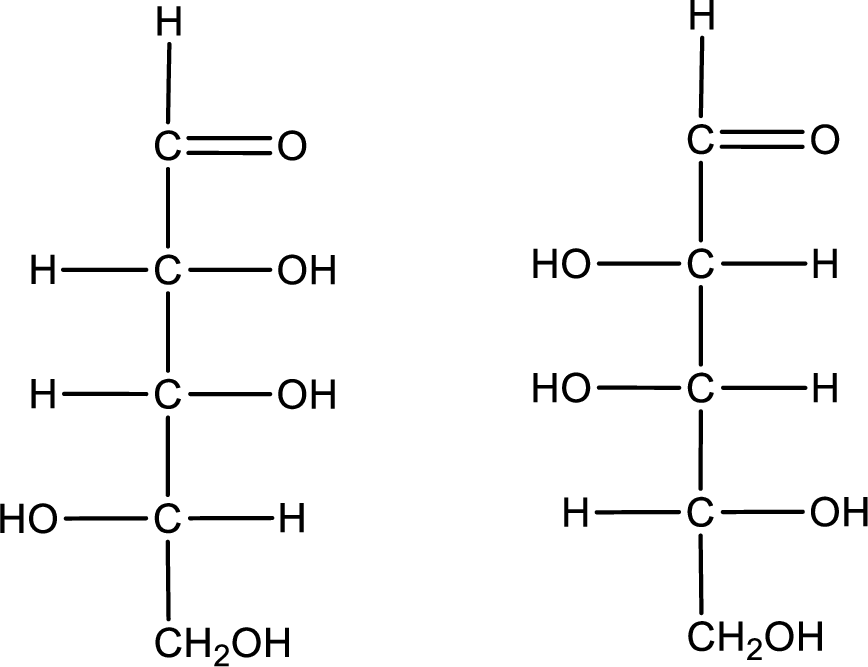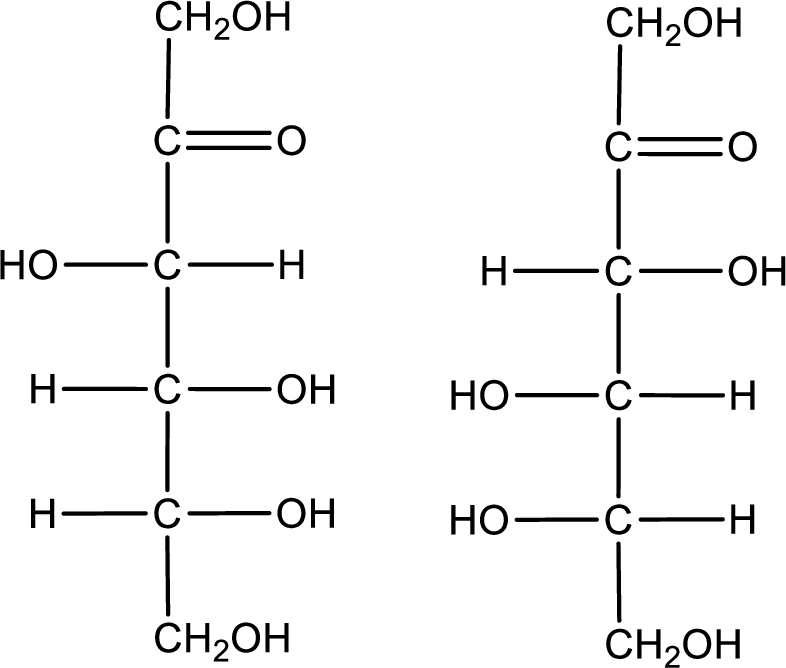
GENERAL ORG+BIOCHEMISTRY CONNECT ONLY
10th Edition
ISBN: 9781265211448
Author: Denniston
Publisher: MCG
expand_more
expand_more
format_list_bulleted
Concept explainers
Question
Chapter 16.4, Problem 16.7Q
(a)
Interpretation Introduction
Interpretation:
Asterisk has to be placed beside the chiral carbon in the below structures.

Concept Introduction:
Chiral carbon is the one that is bonded to four different groups in a compound. Stereoisomers possess chiral carbon atoms in their structure. An example of compound containing chiral carbon is D-Glyceraldehyde. Chiral carbon in the below structure is indicated by asterisk mark.

(b)
Interpretation Introduction
Interpretation:
Asterisk has to be placed beside the chiral carbon in the below structure.

Concept Introduction:
Refer part (a).
(c)
Interpretation Introduction
Interpretation:
Asterisk has to be placed beside the chiral carbon in the below structures.

Concept Introduction:
Refer part (a).
Expert Solution & Answer
Want to see the full answer?
Check out a sample textbook solution
Students have asked these similar questions
no Ai walkthroughs
The answer is shown. What is the reaction mechanism to arrive at the answer?
no Ai walkthroughs
Chapter 16 Solutions
GENERAL ORG+BIOCHEMISTRY CONNECT ONLY
Ch. 16.1 - Prob. 16.1QCh. 16.1 - Why is it important to learn the commonly used...Ch. 16.2 - What is the current recommendation for the amount...Ch. 16.2 - Prob. 16.4QCh. 16.3 - Prob. 16.5QCh. 16.3 - Prob. 16.6QCh. 16.4 - Prob. 16.1PPCh. 16.4 - Prob. 16.2PPCh. 16.4 - Prob. 16.3PPCh. 16.4 - Prob. 16.7Q
Ch. 16.4 - Prob. 16.8QCh. 16.4 - Prob. 16.9QCh. 16.4 - Prob. 16.10QCh. 16.5 - Prob. 16.4PPCh. 16.5 - Prob. 16.11QCh. 16.5 - Prob. 16.12QCh. 16.5 - Prob. 16.5PPCh. 16.7 - Prob. 16.13QCh. 16.7 - Prob. 16.14QCh. 16 - Prob. 16.15QPCh. 16 - Prob. 16.16QPCh. 16 - Prob. 16.19QPCh. 16 - Prob. 16.20QPCh. 16 - Prob. 16.21QPCh. 16 - Prob. 16.22QPCh. 16 - Prob. 16.23QPCh. 16 - Prob. 16.24QPCh. 16 - Prob. 16.25QPCh. 16 - Prob. 16.26QPCh. 16 - Prob. 16.27QPCh. 16 - Prob. 16.28QPCh. 16 - Prob. 16.29QPCh. 16 - Prob. 16.30QPCh. 16 - Prob. 16.31QPCh. 16 - Prob. 16.32QPCh. 16 - Prob. 16.33QPCh. 16 - Prob. 16.34QPCh. 16 - Prob. 16.35QPCh. 16 - Prob. 16.36QPCh. 16 - Prob. 16.37QPCh. 16 - Prob. 16.38QPCh. 16 - Prob. 16.39QPCh. 16 - Prob. 16.40QPCh. 16 - Prob. 16.41QPCh. 16 - Prob. 16.42QPCh. 16 - Prob. 16.43QPCh. 16 - Prob. 16.44QPCh. 16 - Prob. 16.45QPCh. 16 - Prob. 16.46QPCh. 16 - Prob. 16.47QPCh. 16 - Prob. 16.48QPCh. 16 - Prob. 16.49QPCh. 16 - Prob. 16.50QPCh. 16 - Prob. 16.51QPCh. 16 - Prob. 16.52QPCh. 16 - Prob. 16.53QPCh. 16 - Prob. 16.54QPCh. 16 - Prob. 16.55QPCh. 16 - Prob. 16.56QPCh. 16 - Prob. 16.57QPCh. 16 - Prob. 16.58QPCh. 16 - Prob. 16.59QPCh. 16 - Prob. 16.60QPCh. 16 - Prob. 16.61QPCh. 16 - Prob. 16.62QPCh. 16 - Prob. 16.63QPCh. 16 - Prob. 16.64QPCh. 16 - Prob. 16.65QPCh. 16 - Prob. 16.66QPCh. 16 - Prob. 16.67QPCh. 16 - Prob. 16.68QPCh. 16 - Prob. 16.69QPCh. 16 - Prob. 16.70QPCh. 16 - Prob. 16.71QPCh. 16 - Prob. 16.72QPCh. 16 - Prob. 16.73QPCh. 16 - Prob. 16.74QPCh. 16 - Prob. 16.75QPCh. 16 - Prob. 16.76QPCh. 16 - Prob. 16.77QPCh. 16 - Prob. 16.78QPCh. 16 - Prob. 16.79QPCh. 16 - Prob. 16.80QPCh. 16 - Prob. 16.81QPCh. 16 - Prob. 16.82QPCh. 16 - Prob. 16.83QPCh. 16 - Prob. 16.84QPCh. 16 - Prob. 16.85QPCh. 16 - Prob. 16.86QPCh. 16 - Prob. 16.87QPCh. 16 - Prob. 16.88QPCh. 16 - Prob. 16.89QPCh. 16 - Prob. 16.90QPCh. 16 - Prob. 16.91QPCh. 16 - Prob. 16.92QPCh. 16 - Prob. 16.93QPCh. 16 - How does the structure of amylose differ from that...Ch. 16 - Prob. 16.95QPCh. 16 - Prob. 16.96QPCh. 16 - Prob. 16.97QPCh. 16 - Prob. 16.98QPCh. 16 - Prob. 1MCPCh. 16 - Prob. 2MCPCh. 16 - Prob. 4MCPCh. 16 - Prob. 5MCPCh. 16 - Prob. 6MCPCh. 16 - Prob. 7MCPCh. 16 - Prob. 8MCPCh. 16 - Prob. 9MCP
Knowledge Booster
Learn more about
Need a deep-dive on the concept behind this application? Look no further. Learn more about this topic, chemistry and related others by exploring similar questions and additional content below.Similar questions
- Consider the following nucleophilic substitution reaction. The compound listed above the arrow is the solvent for the reaction. If nothing is listed over the arrow, then the nucleophile is also the solvent for the reaction. Part 1 of 2 Br CH,CN + I¯ What is the correct mechanism for the reaction? Select the single best answer. @SN2 ○ SN 1 Part: 1/2 Part 2 of 2 Draw the products for the reaction. Include both the major organic product and the inorganic product. If more than one stereoisomer is possible, draw only one stereoisomer. Include stereochemistry where relevant. Click and drag to start drawing a structure. X હૈarrow_forward20.33 Think-Pair-Share (a) Rank the following dienes and dienophiles in order of increasing reactivity in the Diels-Alder reaction. (i) CO₂Et (ii) COEt || CO₂Et MeO MeO (b) Draw the product that results from the most reactive diene and most reactive dienophile shown in part (a). (c) Draw a depiction of the orbital overlap involved in the pericyclic reaction that oc- curs between the diene and dienophile in part (b). (d) Is the major product formed in part (b) the endo or exo configuration? Explain your reasoning.arrow_forward20.40 The following compound undergoes an intramolecular Diels-Alder reaction to give a tricyclic product. Propose a structural formula for the product. CN heat An intramolecular Diels-Alder adductarrow_forward
- What is the reaction mechanism for this?arrow_forwardWhat is the reaction mechanism for this?arrow_forwardCurved arrows are used to illustrate the flow of electrons. Using the provided starting and product structures, draw the curved electron-pushing arrows for the following reaction or mechanistic step(s). Be sure to account for all bond-breaking and bond-making steps. + Drawing Arrows CH3ONA, CH3OH heat : Br:O Na → H H Br Na + H H H H H :0: .H + Undo Reset Done Q CH3 Drag To Pan +arrow_forward
- What is the reaction mechanism for this?arrow_forward20.19 Predict the structure of the major 1,2-addition product formed by reaction of one mole of Cl₂ with 3-methylenecyclohexene. Also predict the structure of the 1,4-addition product formed under these conditions. 20.20 Which of the two molecules shown do you expect to be the major product formed by 1,2-addition of HCI to cyclopentadiene? Explain. Cyclopentadiene + HC 3-Chlorocyclopentene (racemic) or 4-Chlorocyclopentene (racemic)arrow_forward20.35 Propose structural formulas for compounds A and B and specify the configuration of compound B. EtO₂C 250°C C14H2004 CO₂Et 1. Oso, then NaHSO3 2. HIO4 C14H2006 A Barrow_forward
arrow_back_ios
SEE MORE QUESTIONS
arrow_forward_ios
Recommended textbooks for you
 ChemistryChemistryISBN:9781305957404Author:Steven S. Zumdahl, Susan A. Zumdahl, Donald J. DeCostePublisher:Cengage Learning
ChemistryChemistryISBN:9781305957404Author:Steven S. Zumdahl, Susan A. Zumdahl, Donald J. DeCostePublisher:Cengage Learning ChemistryChemistryISBN:9781259911156Author:Raymond Chang Dr., Jason Overby ProfessorPublisher:McGraw-Hill Education
ChemistryChemistryISBN:9781259911156Author:Raymond Chang Dr., Jason Overby ProfessorPublisher:McGraw-Hill Education Principles of Instrumental AnalysisChemistryISBN:9781305577213Author:Douglas A. Skoog, F. James Holler, Stanley R. CrouchPublisher:Cengage Learning
Principles of Instrumental AnalysisChemistryISBN:9781305577213Author:Douglas A. Skoog, F. James Holler, Stanley R. CrouchPublisher:Cengage Learning Organic ChemistryChemistryISBN:9780078021558Author:Janice Gorzynski Smith Dr.Publisher:McGraw-Hill Education
Organic ChemistryChemistryISBN:9780078021558Author:Janice Gorzynski Smith Dr.Publisher:McGraw-Hill Education Chemistry: Principles and ReactionsChemistryISBN:9781305079373Author:William L. Masterton, Cecile N. HurleyPublisher:Cengage Learning
Chemistry: Principles and ReactionsChemistryISBN:9781305079373Author:William L. Masterton, Cecile N. HurleyPublisher:Cengage Learning Elementary Principles of Chemical Processes, Bind...ChemistryISBN:9781118431221Author:Richard M. Felder, Ronald W. Rousseau, Lisa G. BullardPublisher:WILEY
Elementary Principles of Chemical Processes, Bind...ChemistryISBN:9781118431221Author:Richard M. Felder, Ronald W. Rousseau, Lisa G. BullardPublisher:WILEY

Chemistry
Chemistry
ISBN:9781305957404
Author:Steven S. Zumdahl, Susan A. Zumdahl, Donald J. DeCoste
Publisher:Cengage Learning

Chemistry
Chemistry
ISBN:9781259911156
Author:Raymond Chang Dr., Jason Overby Professor
Publisher:McGraw-Hill Education

Principles of Instrumental Analysis
Chemistry
ISBN:9781305577213
Author:Douglas A. Skoog, F. James Holler, Stanley R. Crouch
Publisher:Cengage Learning

Organic Chemistry
Chemistry
ISBN:9780078021558
Author:Janice Gorzynski Smith Dr.
Publisher:McGraw-Hill Education

Chemistry: Principles and Reactions
Chemistry
ISBN:9781305079373
Author:William L. Masterton, Cecile N. Hurley
Publisher:Cengage Learning

Elementary Principles of Chemical Processes, Bind...
Chemistry
ISBN:9781118431221
Author:Richard M. Felder, Ronald W. Rousseau, Lisa G. Bullard
Publisher:WILEY